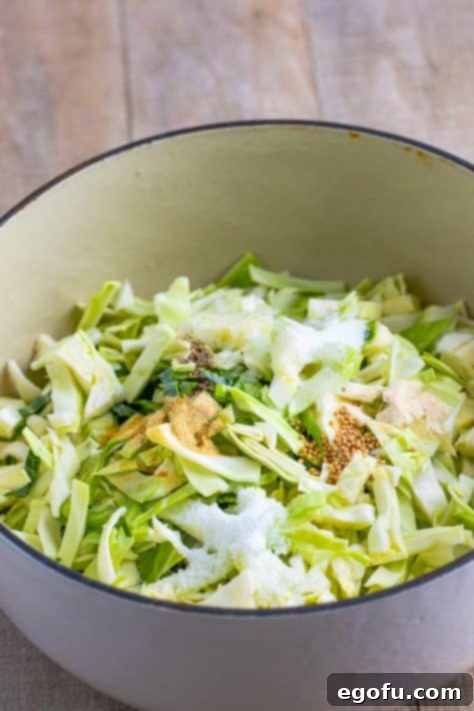Welcome to the ultimate guide for making Quick Sauerkraut at home! If you love the tangy, crisp flavor of homemade sauerkraut but dread the weeks of waiting for fermentation, then this recipe is your culinary dream come true. Say goodbye to lengthy fermentation processes and hello to delicious, ready-to-eat sauerkraut in under an hour. This isn’t just fast; it’s a game-changer for anyone who enjoys the vibrant taste of sauerkraut on demand. Forget the store-bought versions that often lack the authentic zest and satisfying crunch; with this simple method, you’ll be enjoying fresh, flavorful sauerkraut whenever the craving strikes.
HOMEMADE SAUERKRAUT IN UNDER AN HOUR: NO FERMENTATION REQUIRED
There’s an undeniable magic to homemade food, and sauerkraut is no exception. While traditional sauerkraut relies on a natural fermentation process that can take weeks, this quick recipe offers an incredible shortcut without sacrificing flavor. We understand that time is a precious commodity, and waiting patiently for ferments can be challenging. This method provides the perfect solution, delivering that distinctive tangy taste and a delightful crunch that many prefer over the softer texture of fully fermented kraut. Imagine the satisfaction of preparing a batch of delicious, vibrant sauerkraut from scratch and having it ready to serve in less than 60 minutes. It’s truly a revelation!
The beauty of this easy sauerkraut recipe lies in its simplicity and speed. You’ll achieve a wonderfully tart and aromatic sauerkraut that rivals its fermented counterpart in taste, yet offers a fresher, slightly crisper bite. Whether you’re new to making sauerkraut or a seasoned pro looking for a faster alternative, this approach is guaranteed to impress. I was genuinely thrilled with the outcome when I first tried it – the flavor was so bright and inviting, I could hardly resist eating it straight from the pot!

FREQUENTLY ASKED QUESTIONS (FAQ’S) ABOUT QUICK SAUERKRAUT
Unlike traditional fermented sauerkraut, which can sometimes produce a strong, distinct aroma during its fermentation period, this quick sauerkraut recipe primarily smells of vinegar during the cooking process. If you’ve ever simmered a vinegar-based BBQ sauce or pickled vegetables, you’ll be familiar with this scent. The smell will certainly fill your kitchen while it cooks, but it dissipates quickly once the cooking is done and the sauerkraut is cooled and stored. If you’re not a fan of vinegar aromas, it might be noticeable, but it’s generally far less pungent than the long-term fermentation smell of traditional kraut.
The fundamental difference lies in the preparation method: regular sauerkraut is made through a natural lactic acid fermentation, which takes several weeks to develop its characteristic sour flavor and tender texture, and also introduces beneficial probiotics. This no-ferment sauerkraut, on the other hand, achieves its tanginess quickly by simmering cabbage in a vinegar-based brine. This means our quick version skips the fermentation step entirely, resulting in a sauerkraut that’s ready in minutes instead of weeks. You’ll notice that the quick version retains a pleasant crunch, offering a different textural experience compared to the softer, more yielding traditional sauerkraut. While it doesn’t offer the probiotic benefits of fermented kraut, it delivers all the classic flavors and versatility you love.
This versatile fast sauerkraut is a fantastic addition to a myriad of dishes. It’s an absolute must-have for anything Reuben-inspired, from classic Reuben sandwiches to creative Reuben Sliders, savory Reuben Dip, or comforting Reuben Casserole. Beyond that, it shines on grilled favorites like juicy hot dogs and hearty bratwurst, elevating simple sandwiches to gourmet status. Get creative and try it as a vibrant topping for shrimp tacos, or sauté it with smoked kielbasa for a quick and satisfying meal. Of course, it’s a perfect partner for corned beef, just as you’d enjoy traditional sauerkraut. Basically, anywhere you typically reach for sauerkraut, this quick version will fit right in!
In this recipe, we use a combination of white distilled vinegar and apple cider vinegar to achieve a balanced, complex tang. The white vinegar provides a sharp, bright acidity, while the apple cider vinegar contributes a slightly mellow, fruitier, and more nuanced tartness. This blend creates a depth of flavor that we believe truly enhances the sauerkraut. However, if you only have one type on hand, you can certainly use just white distilled vinegar or just apple cider vinegar. The flavor profile will shift slightly, but your homemade quick sauerkraut will still be delicious.
Absolutely! Personal preference is key when it comes to flavor. If you prefer a milder, less tart sauerkraut, you can easily adjust the acidity. Simply reduce the amount of both vinegars by half and replace that liquid volume with additional water. This will dilute the vinegar’s potency, resulting in a more subtle sourness while still imparting that essential kraut flavor. Experiment with the ratios to find your perfect balance!
While you have the option to omit some of the seasonings for a truly plain sauerkraut, we highly recommend including them. The black pepper, garlic powder, mustard seeds, and onion powder are carefully chosen to elevate this recipe from a basic pickled cabbage to a truly flavorful side dish. Since this sauerkraut is not fermented, these aromatic spices play a crucial role in developing a rich, savory depth that mimics the complexity of traditional kraut. They add warmth, pungency, and a wonderful aromatic quality that you won’t want to miss.
Yes, absolutely! Freezing is an excellent way to extend the shelf life of your quick homemade sauerkraut. To freeze it effectively, allow the sauerkraut to cool completely after cooking. Then, transfer it to airtight, freezer-safe containers or heavy-duty freezer bags, removing as much air as possible to prevent freezer burn. It can be kept frozen for up to 3 months. When you’re ready to enjoy it, simply thaw it in the refrigerator overnight and reheat gently if desired. The texture might soften slightly after freezing and thawing, but the flavor will remain fantastic.
Caraway seeds are a classic addition to many sauerkraut recipes, and they introduce a distinctive, slightly anise-like, earthy flavor that many adore. We know it’s an ingredient that divides opinions – people either love it or hate it! If you’re a fan, you can definitely add them to this recipe. We recommend starting with about ½ teaspoon of caraway seeds, added along with the other spices. This amount typically provides a noticeable yet balanced flavor without overpowering the other ingredients. Feel free to adjust to your personal taste.
Proper storage is essential to keep your quick sauerkraut fresh and delicious. Once cooled, transfer any leftover kraut into clean, lidded jars or other airtight containers. It must be stored in the refrigerator and will keep well for up to 2 weeks. It’s important to remember that because this sauerkraut is not fermented, it does not have the same long-term shelf stability as traditionally fermented kraut. Therefore, it cannot be safely stored on a pantry shelf at room temperature. For the same reason, it is also not recommended to can (preserve using traditional canning methods) unfermented sauerkraut, as it lacks the acidity levels required for safe shelf-stable canning without fermentation.
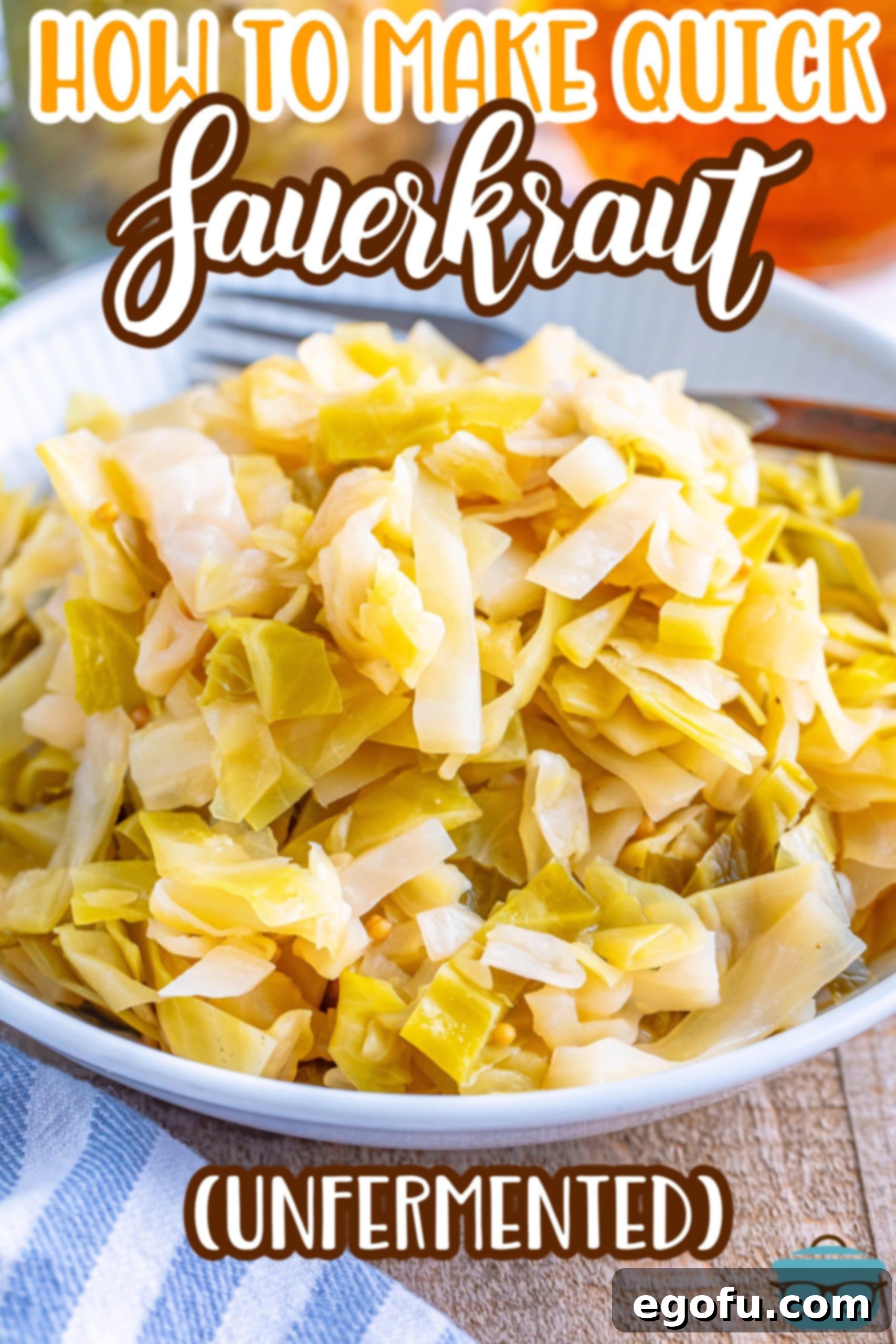
ESSENTIAL INGREDIENTS FOR YOUR QUICK SAUERKRAUT
Crafting delicious quick sauerkraut requires just a few simple, accessible ingredients. Each component plays a vital role in building the perfect tangy, savory flavor profile and desired texture. Here’s a closer look at what you’ll need:
- Green Cabbage: The star of our show! You’ll need one large head of green cabbage, thinly sliced. Green cabbage holds up beautifully during cooking and provides that characteristic crunch. If you prefer, red cabbage can also be used, which will give your sauerkraut a beautiful vibrant purple hue and a slightly different, though equally delicious, flavor.
- Apple Cider and White Distilled Vinegar: This dynamic duo forms the backbone of our quick pickling liquid. White distilled vinegar contributes a sharp, clean acidity, while apple cider vinegar adds a milder, fruitier tang and a subtle depth that enhances the overall flavor. This combination ensures a perfectly balanced sourness without being overwhelming.
- Salt: Essential for both flavor and drawing out moisture from the cabbage, contributing to its tender-crisp texture. You can use kosher salt or regular table salt. Many cooks prefer kosher salt for its texture and pure flavor, but either will work effectively.
- Granulated Sugar: Don’t worry, this isn’t to make your sauerkraut sweet! The small amount of granulated sugar acts as a crucial balancer, mellowing the intense acidity of the vinegars and highlighting the natural flavors of the cabbage and spices. It creates a well-rounded taste without making the sauerkraut noticeably sweet.
- Black Pepper, Garlic Powder, Mustard Seeds, Onion Powder: These seasonings are the secret to giving our fast sauerkraut its authentic depth, especially since it’s not fermented. Black pepper adds a hint of warmth, garlic and onion powders provide savory aromatics, and mustard seeds contribute a distinctive, slightly pungent, and earthy note. It’s vital to use mustard seeds, not powdered mustard, which can make the kraut cloudy and yellow. You can also add ½ teaspoon of caraway seeds for a more traditional flavor profile, if desired. While optional, these spices truly elevate the flavor, making it incredibly satisfying. If you prefer a very plain sauerkraut, you can omit them, but we highly recommend them for the best results.
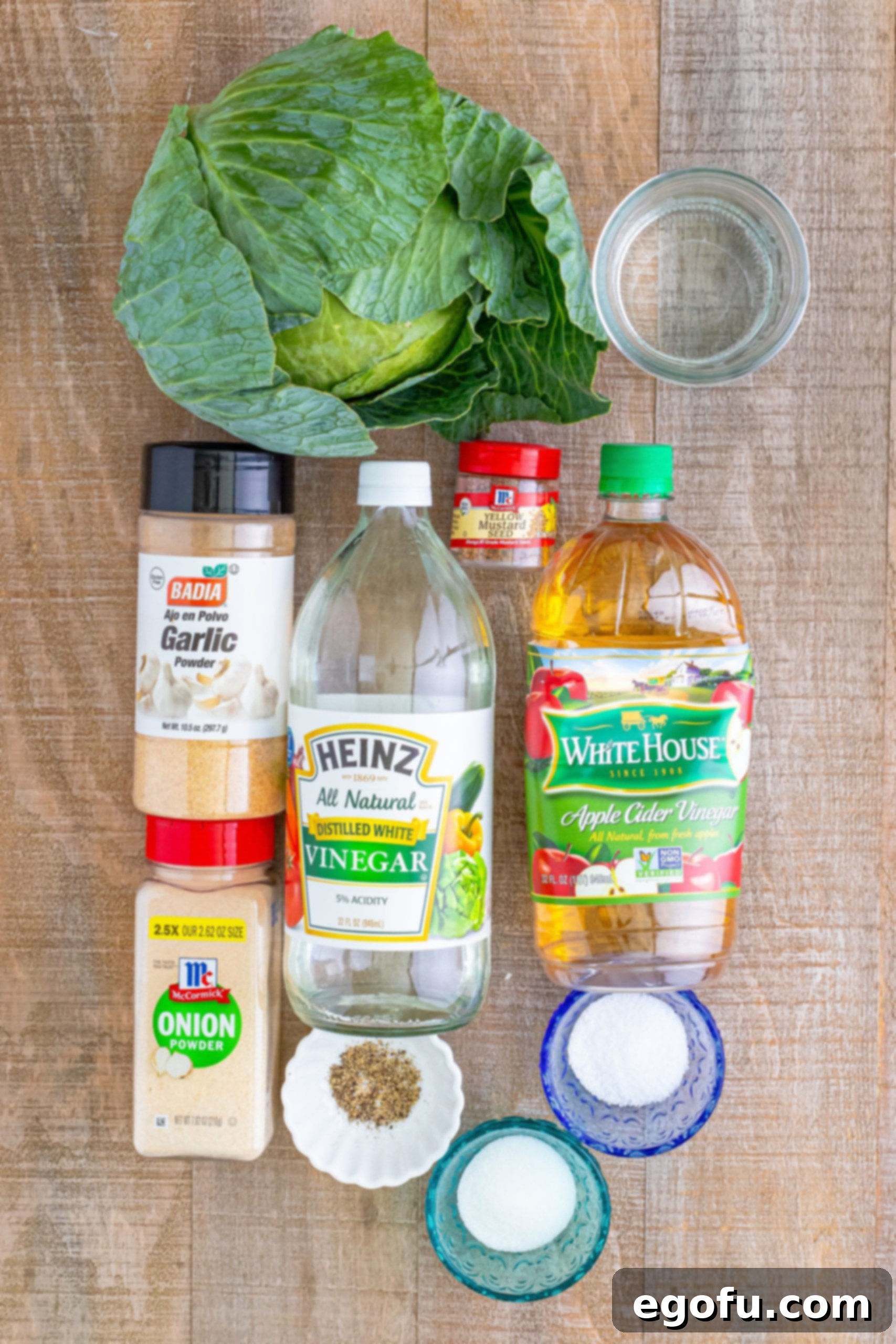
HOW TO MAKE QUICK SAUERKRAUT: A STEP-BY-STEP GUIDE
Making this speedy version of sauerkraut is incredibly straightforward. Follow these simple steps to create a batch of perfectly tangy and tender-crisp kraut in no time:
Step 1: Prepare the Cabbage
Begin by thinly slicing your green cabbage. A mandoline slicer can make this task quicker and more uniform, but a sharp knife works perfectly well too. Once sliced, place all of the shredded cabbage into a large Dutch oven or a sturdy, spacious pot. Ensure your pot is large enough to comfortably hold all the cabbage and the liquid. This forms the base of your delicious sauerkraut.
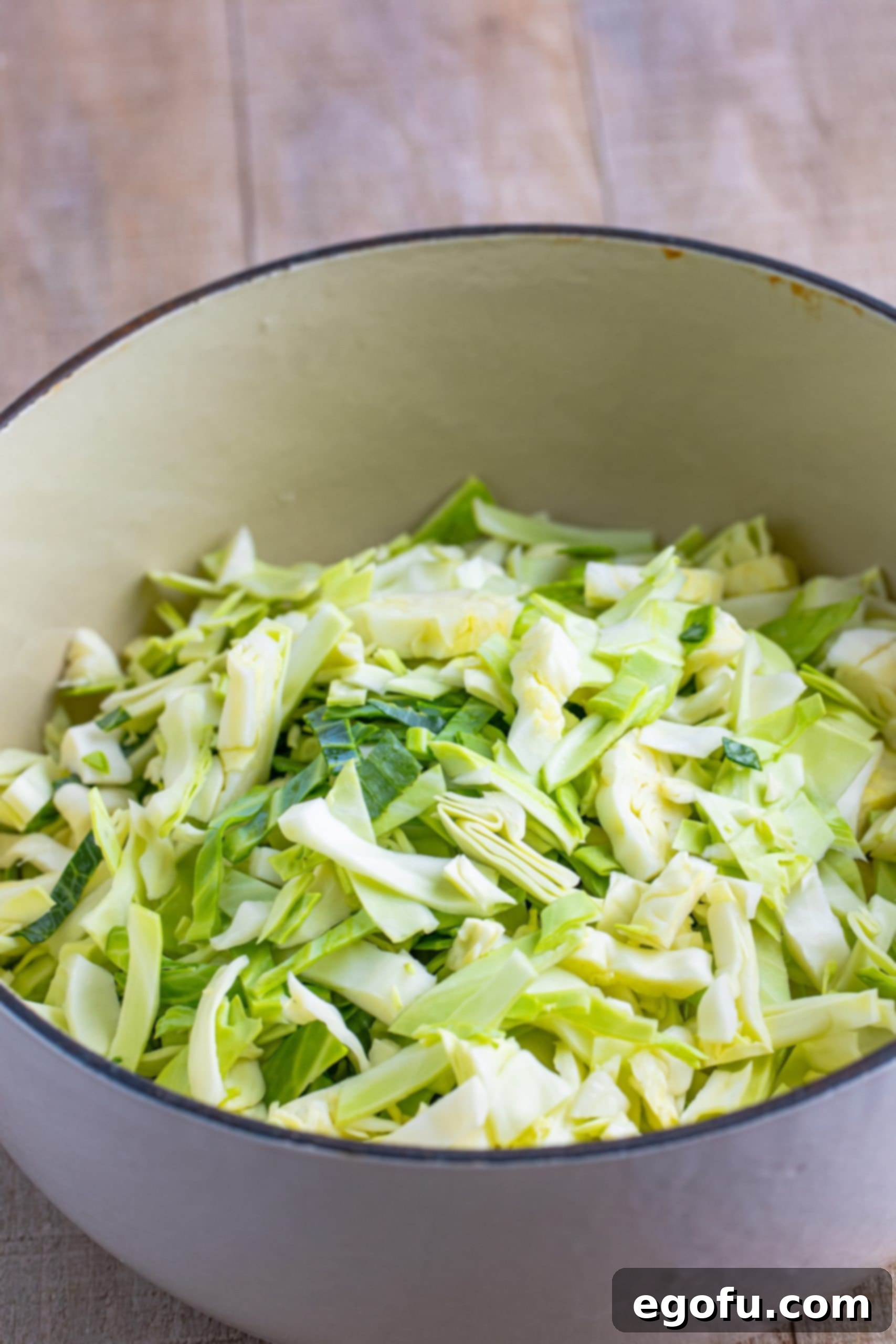
Step 2: Add the Liquid and Seasonings
Pour in the water, apple cider vinegar, and white distilled vinegar over the sliced cabbage. Then, add the salt, granulated sugar, black pepper, garlic powder, mustard seeds, and onion powder. Give everything a good stir to ensure all the ingredients are well combined and the cabbage is coated with the flavorful liquid and spices. This mixture will create the perfect pickling brine.
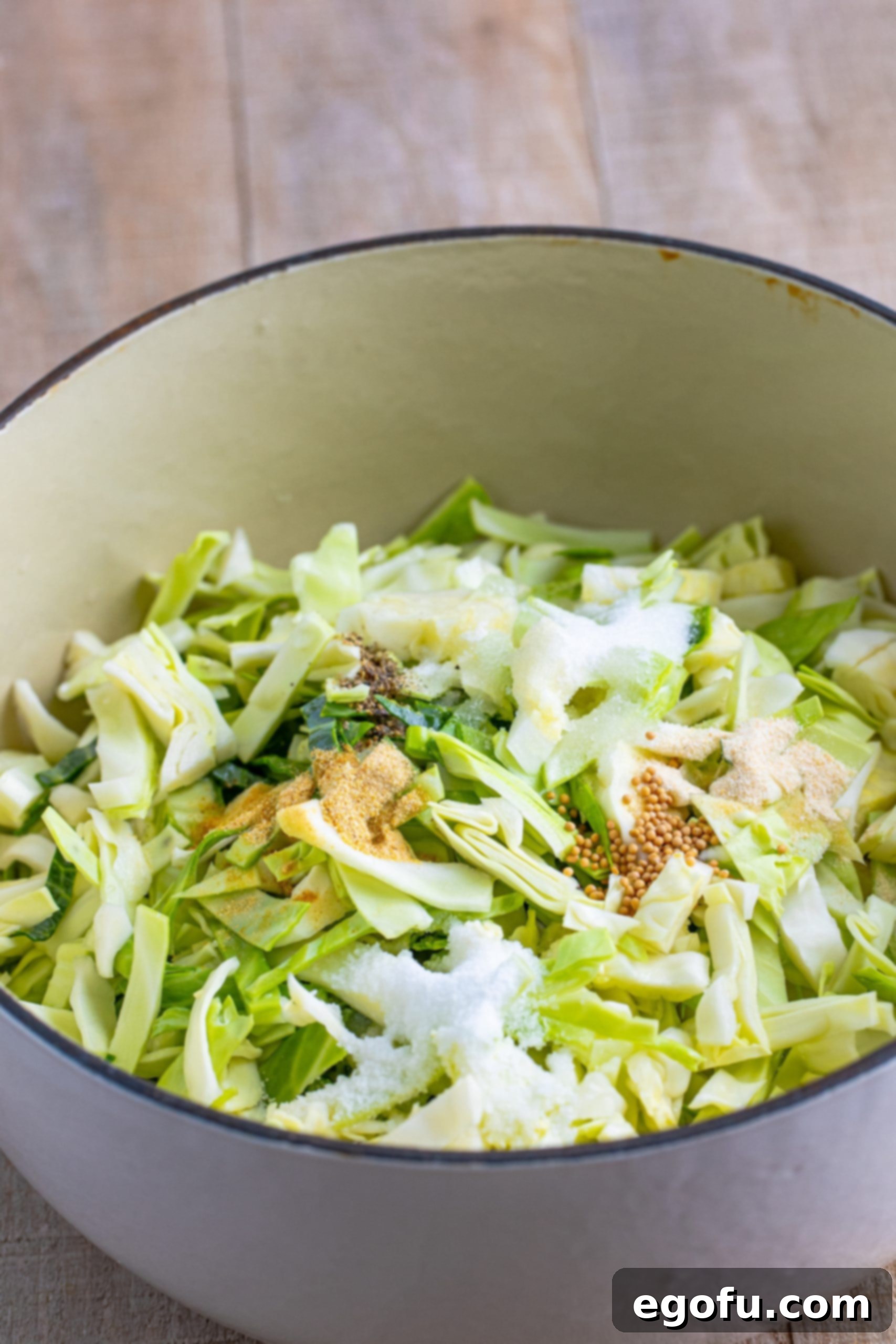
Step 3: Simmer to Perfection
Place your pot on the stove over medium heat. Bring the mixture to a gentle simmer, stirring occasionally to distribute the heat and prevent sticking. Once it reaches a consistent simmer, reduce the heat to medium-low. This lower heat will allow the cabbage to soften gradually and absorb the flavors without overcooking or burning. Keep a watchful eye, as a gentle simmer is key to achieving the desired texture and taste.
Step 4: Cook Until Tender and Serve
Continue to cook the sauerkraut, uncovered, for approximately 35-40 minutes, or until the cabbage reaches your desired level of tenderness. Throughout this cooking time, make sure to stir the sauerkraut at least every 5 minutes. This regular stirring is crucial to prevent the cabbage from sticking to the bottom of the pot and potentially burning. Once tender, your quick homemade sauerkraut is ready to be enjoyed! Serve it immediately as a warm side dish, or allow it to cool before transferring to lidded jars or airtight containers for refrigeration. It’s that easy to enjoy delicious sauerkraut anytime you wish!

CRAVING MORE DELICIOUS RECIPES?
If you’ve enjoyed making this quick sauerkraut, you might be interested in exploring more of our flavorful recipes that complement it or offer similar home-style comfort. These dishes are perfect for expanding your culinary repertoire!
- Homemade Sauerkraut (Fermented)
- Chicken Schnitzel
- Refrigerator Pickles
- Homemade Sweet Pickle Relish
- Dill Pickle Relish
- Bacon Fried Cabbage
- Chow Chow
- Pickled Red Onions
- Hot Dog Chili
- Homemade Tartar Sauce
- Cabbage Rolls
- Crock Pot Unstuffed Cabbage Rolls
- Crock Pot Brats
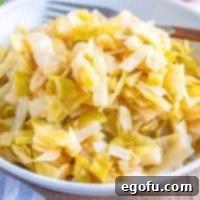
Quick Sauerkraut
Skip the waiting time for your homemade sauerkraut to ferment and learn to make Quick Sauerkraut with this easy recipe so you can enjoy it anytime you want!
Prep Time: 10 minutes
Cook Time: 40 minutes
Total Time: 50 minutes
Servings: 8 servings
Author: Brandie Skibinski
Ingredients
- 1 head green cabbage, thinly sliced (about 2.5 pounds, outer leaves removed and cored)
- 1 cup water
- ½ cup apple cider vinegar
- ½ cup white distilled vinegar
- 2 teaspoons salt
- 2 teaspoons granulated sugar
- ½ teaspoon black pepper
- ½ teaspoon garlic powder
- ½ teaspoon mustard seeds
- ½ teaspoon onion powder
Instructions
Place the 1 head green cabbage, thinly sliced into a Dutch oven or large pot.

Add 1 cup water, 1/2 cup apple cider vinegar, 1/2 cup white distilled vinegar, 2 teaspoons salt, 2 teaspoons granulated sugar, 1/2 teaspoon black pepper, 1/2 teaspoon garlic powder, 1/2 teaspoon mustard seeds and 1/2 teaspoon onion powder. Stir to combine.

Place on the stove over medium heat, and bring to a simmer, stirring occasionally. Once at a simmer, reduce to medium-low heat.

Continue to cook, uncovered, until the cabbage is tender, 35-40 minutes. Make sure to stir it at least every 5 minutes so nothing sticks to the bottom and burns.

Serve immediately or store in lidded jars or containers and put into the refrigerator.

Notes
- Please refer to my FAQ’s (Frequently Asked Questions) and ingredient list above for other substitutions or for the answers to the most common questions.
Course: Side Dish
Cuisine: American
Nutrition
Calories: 41kcal | Carbohydrates: 8g | Protein: 2g | Fat: 0.2g | Sodium: 605mg | Fiber: 3g | Sugar: 5g
Nutritional Disclaimer
“The Country Cook” is not a dietician or nutritionist, and any nutritional information shared is an estimate. If calorie count and other nutritional values are important to you, we recommend running the ingredients through whichever online nutritional calculator you prefer. Calories and other nutritional values can vary quite a bit depending on which brands were used.
Did you make this recipe?
Share it on Instagram @thecountrycook and mention us #thecountrycook!


